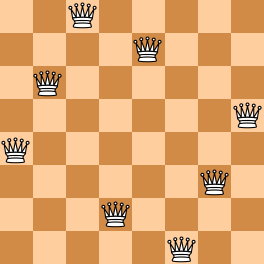1128 N Queens Puzzle(20 分)(cj)
1128 N Queens Puzzle(20 分)
The "eight queens puzzle" is the problem of placing eight chess queens on an 8×8 chessboard so that no two queens threaten each other. Thus, a solution requires that no two queens share the same row, column, or diagonal. The eight queens puzzle is an example of the more general N queens problem of placing Nnon-attacking queens on an N×N chessboard. (From Wikipedia - "Eight queens puzzle".)
Here you are NOT asked to solve the puzzles. Instead, you are supposed to judge whether or not a given configuration of the chessboard is a solution. To simplify the representation of a chessboard, let us assume that no two queens will be placed in the same column. Then a configuration can be represented by a simple integer sequence (Q1,Q2,⋯,QN), where Qi is the row number of the queen in the i-th column. For example, Figure 1 can be represented by (4, 6, 8, 2, 7, 1, 3, 5) and it is indeed a solution to the 8 queens puzzle; while Figure 2 can be represented by (4, 6, 7, 2, 8, 1, 9, 5, 3) and is NOT a 9 queens' solution.
 |
 |
|---|---|
| Figure 1 | Figure 2 |
Input Specification:
Each input file contains several test cases. The first line gives an integer K (1<K≤200). Then K lines follow, each gives a configuration in the format "N Q1 Q2 ... QN", where 4≤N≤1000 and it is guaranteed that 1≤Qi≤N for all i=1,⋯,N. The numbers are separated by spaces.
Output Specification:
For each configuration, if it is a solution to the N queens problem, print YES in a line; or NO if not.
Sample Input:
4
8 4 6 8 2 7 1 3 5
9 4 6 7 2 8 1 9 5 3
6 1 5 2 6 4 3
5 1 3 5 2 4
Sample Output:
YES
NO
NO
YEScode
#pragma warning(disable:4996)
#include <iostream>
#include <vector>
#include <queue>
using namespace std;
bool bol(vector<int>& v, int n);
int main() {
int k, n, x;
cin >> k;
while (k--) {
cin >> n;
vector<int> varr;
for (int i = 0; i < n; ++i) {
cin >> x;
varr.push_back(x);
}
if (bol(varr, n)) cout << "YES" << endl;
else cout << "NO" << endl;
}
system("pause");
return 0;
}
bool bol(vector<int>& v, int n) {
for (int i = 1; i <= n; ++i) {
for (int j = 1; j < i; ++j) {
if (v[j-1] == v[i-1]) return 0;
if (v[j - 1] - v[i - 1] == j - i) return 0;
if (v[j - 1] - v[i - 1] == i - j) return 0;
}
}
return 1;
}